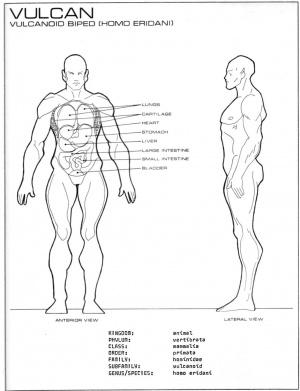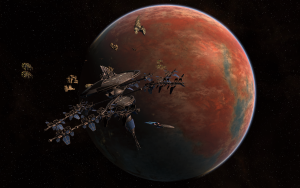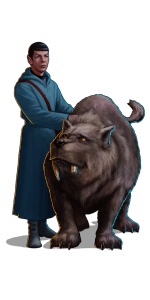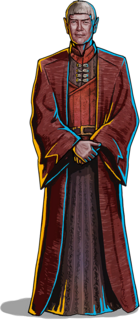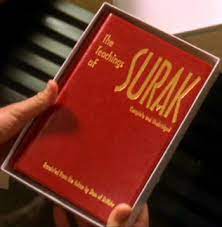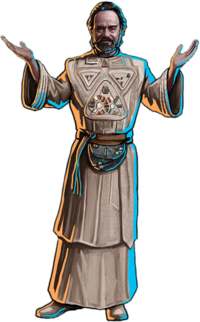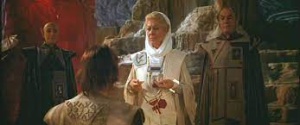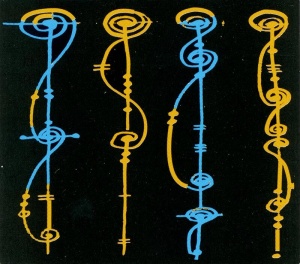Vulcan
From Star Trek: Theurgy Wiki
| Vulcan | |
| Planet of Origin: | Vulcan |
| Affiliation: | United Federation of Planets |
| Warp Capable: | 1440 AD |
| Borg Designation: | Species 3259 |
| Biology | |
|---|---|
| Classification: | mammalian humanoid |
| Environmental Requirements: | warm Class M conditions |
| Typical Lifespan: | 200 years |
| Sexes: | male, female |
| Telepathic Abilities: | touch telepath |
| Blood Coloration: | green (copper-based) |
| Distinctive Features: pointed ears and eyebrows | |
| Racial Sub-Divisions: varied skin and eye coloration | |
| Vulcan characters in Star Trek: Theurgy: | |
The Needs of the Many Outweigh the Needs of the Few, or the One.
The Vulcans were a stoic, rational people. Widely claimed to be emotionless, in truth the Vulcans felt deeply and intensely, to their own detriment. Their stoicism came from a culture of logic and self-discipline, where emotions were analyzed and dissected to rob them of their potency so that they could not overwhelm or control the individual. Vulcans embraced science and reason, but their lives were not purely devoted to logic: they also had a deeply philosophical side, with art and music as vital to their culture as logic. They were also intensely private people, with many aspects of their culture — such as the rites of Pon Farr — which were not discussed amongst outsiders.[1]
Psychology
Vulcans exalted logic over emotion and usually repressed or sublimated emotions in their daily behavior. Vulcans who dealt with non-Vulcans on a regular basis often maintained an almost glacial calm, possibly as self-defense against so much unguarded feeling. Among themselves, however, Vulcans usually seemed more relaxed; Vulcan ambassadors often cultivated a kind of distant good humor and politesse. Even Vulcan ambassadors, however, had trouble predicting or depending upon the behavior of more emotional species.
Surak's teachings were the most important philosophical essays in Vulcan history, detailing the use of logic and reason in order to control warring emotions and destructive tendencies. In the beginning, Vulcans used their emotions as a tool, preferring to apply logic to justify their actions. AS the race evolved and the teachings of Surak spread, however the use of various techniques to banish and suppress emotions became more prevalent and Vulcan psychology blossomed. The understanding of one's mind and mental processes as well as one's emotional reactions became a necessity, and psychology was applied not only to one' own actions but also to understanding the actions of others.
The foremost psychologists on Vulcan belonged to the religious orders that guide Vulcan society. Surak's school the largest and most popular sect of Vulcan beliefs, advocated the study and understanding of emotional desires, so that the student can suppress and control them. Constant study of this process, as well as assisting others in achieving mastery of psionics through control of emotion, caused the devotees of this doctrine to become experts on the workings and common psychological traumas of Vulcan minds.
The school of Surak had many techniques which can open the mind of a student, perceiving where the student's difficulties and strongest emotions lie and adjusting the mind's processes so that the student can more completely face the emotion and learn to control it. Thus, they are experienced in abnormal psychology as well as the common workings of Vulcan minds. When a Vulcan is unable to control his emotions, his family or colleagues often summon a devotee of Surak to deal with him. When a Vulcan willingly gives in to his emotions, it is one goal of those who follow the doctrines of Surak to help him resolve his problems and rejoin society.
One of the most contemplated teachings of Surak was his admonition that one should study reason above all else. ("The chief subject of reason is reason") Surak taught that a Vulcan should learn to discern reality both as it seems to be and as it truly was. This dissection of truth from illusion spurred Vulcans into intense study of science and mathematics, helping them dissect many of the most complex workings of the universe into logical steps. Patience, temperance, and logical observation (truthfulness to the world) were three of the greatest virtues of Vulcan culture and all had great application to scientific reasoning. Vulcans believed that their adherence to this doctrine made them the foremost scientists in the Federation.
The application of these virtues, combined with intense meditation, gave Vulcans great control over their native psionic abilities. They remained unable to control that most famous biological trigger of Vulcan mental abilities, the pon farr.
Physiology
Vulcans closely resembled Humans, with the same average height and weight. Their pointed ears were slightly larger than the Human norm, and their slanted eyebrows sometimes gave them a questioning look. The inner, or nictitating, eyelid was not visible. Vulcan skin complexions ranged from olive to dark mahogany, with a green cast provided by their copper-based blood. The Vulcan heart rested in the lower center of the torso, surrounded and protected by highly efficient lungs.
Externally Vulcans seemed to have much in common with Terrans, Vulcan internal physiology is quite different.
Body Size and Shape
Males and females were of similar height and stature, averaging 2 meters in height and 70 kilos in weight. Although their structure and frame were of similar height to those of Terrans, their strength was derived from longer muscle mass and a dense skeletal frame, the consequences of evolution in Vulcan's higher gravity and thinner atmosphere. One other significant difference from Terran physiology was the distinct lack of Vulcan sweat glands. Vulcans used blood, skin, and body structure to cool themselves rather than perspiration, which would have been inefficient given the high temperatures on the planet Vulcan.
Skin
Vulcan epidermis was unlike any other in the galaxy. Forming a two-way moisture-proof shield, it protected Vulcans from external liquids and pressure, as well as maintaining the inner temperature and liquid environment of their organs. Because Vulcan blood was copper-based rather than iron-based, it was green in color and was extremely effective in separating and utilizing the smaller amounts of oxygen available in Vulcan's low-pressure mildly irradiated environment. Due to this specialization of their blood and blood cells, Vulcans could survive for several minutes under water or in any oxygen-poor environment, as long as there was a small amount of oxygen available.
Brain
Not much was known about the Vulcan brain, although it was clear from even the simplest autopsy that the Vulcan midbrain is larger and more complex, and contains more nerve endings and blood capillaries than similar areas of Terran brains. The only other major species known to have possessed such a large percentage of midbrain was the Betazoid race, whose midbrain comprises nearly 65% of their entire brain mass. Vulcan midbrains were significantly smaller, averaging only 45% of the organ, yet this is still much more than comparative races. It was assumed that the majority of Vulcan psionic powers came from this enlarged region, although testing has been inconclusive.
Eyes
A clear inner eyelid formed of a nictitating membrane that filtered radiation, dust, and other harmful elements protected Vulcan eyes. Vulcan range of vision was more acute, as was their ability to recognize color frequencies and perceived more clearly at a distance. This seemed to have certain negative drawbacks as many Vulcans describe painful symptoms, similar to headaches and eyestrain, from being exposed to vibrant high colorations for long periods of time. The Vulcan optic nerve, much more delicate and sensitive than a typical Terran nerve, was more prone to disease and degeneration.
Ears
One of the most commonly noted differences between Terran and Vulcan physiology was the shape and structure of the earlobe and the functioning of the Vulcan inner ear. Although the Vulcan ear shape helped to funnel sound and intensify the reception of harmonics, the internal structure of the eardrum is very different, formed of no fewer than three separate functioning eardrums. These eardrums seemed to respond to differing volume and pitch, relaying the sound through separate channels to the nerve centers of the brain. Each worked independently, and in Vulcans of advanced age it was most often the low-pitched eardrum that deteriorates.
Skull
Vulcans had only 28 teeth, lacking rear molars and possessed a longer mandibular movement than most bipedal species. Although the bone structure of the Vulcan skull is thinner, the actual skull casing was formed of extremely dense matter, allowing a thinner depth of bone actually to be harder and stronger than a human skull.
Heart
Vulcan internal organs tended to operate at a much faster rate than those of comparable species, with an average heart rate as 265 beats per minute. The Vulcan heart lied in the center of the torso, surrounded by a large lung structure, capable of holding approximately 20% more capacity than Terran lungs. The Vulcan torso, ribcage, and musculature were also significantly longer, in order to encompass the organs within.
Vulcan hormonal activity was under muscular control and could be regulated by conscious processes of trained Vulcans. Thus, it was possible that a Vulcan could control his adrenaline, thyroid, and other metabolic systems, causing a change in heart rate, oxygen consumption, and other bodily resources. This accounts for the amazing Vulcan capacity to "regenerate" wounds, using a special trance state in order to repair any internal or structural damage more efficiently. The one primary exception to this rule was the reproductive hormone complex released during the Pon farr, in which a hormone known as yamareen was released into the bloodstream of the mature male Vulcan. Although the female Vulcan be impregnated after her menstrual cycle began (typically as early as age 16 and as late as 25), the male Vulcan was incapable of creating progeny until after the onset of his first pon farr. Thereafter, the Vulcan male is capable of reproducting, but must obey the physical urge to mate every seven years, during the pon farr. Vulcans, humans, and Klingons were all interfertile, giving credence to theories that all three races sprang from common ancestors seeded by the Preservers.
Reproduction
The biological and anthropological origins of pon farr remained unclear, and Vulcan modesty defeated Vulcan curiosity, leaving the subject mostly unstudied. The secretion of a hormone complex known yamareen caused the pon farr, or mating cycle. Difficult to produce scientifically, all attempts to create yamareen in laboratory experiments were unsuccessful. In the prehistoric phase of Vulcan, men fought to the death regularly for the right to mate with females. This kept the population down (useful on a desert planet) and ensured that only the strongest survived to reproduce. It also hindered the growth of Vulcan society, as men would not cooperate with others who could soon be their deadly enemies.
Pon farr occurred every seven years, regardless of physical condition or the Vulcan's social capacity to mate. Those who felt the "blood stirring" did not always have the luxury of being ceremonially joined to another Vulcan. In this case, they were free to choose their mate as they saw fit, hoping that they would be accepted. If a Vulcan was rejected or if his pon farr is allowed to continue without mating, he was said to suffer from plak tow, the "blood fever."
Plak tow was extremely dangerous and could result in death if not carefully controlled. Those around a plak tow sufferer would not speak his name out of courtesy. Ideally, this was the Vulcan way of "ignoring" the incident's occurrence at all, allowing the sufferer to endure with a minimum of stigma from other Vulcans. This habit caused many deaths because a series of intense meditations and rigorous physical disciplines was required to survive an unrequited plak tow, and even those methods were not always successful.
Vulcans reverted to ancient mating ceremonies during their pon far, attempting to cover their emotional abandon with logic and ancient ritual. The parents of both parties, as well as representatives from the School of Surak or other religious orders, oversaw the mating contract. This ritual began well before puberty, to minimize irrational behavior and channel it toward social cohesion rather than the rutting madness that split Vulcan apart during its prehistory.
At age seven, Vulcans ceremonially bonded telepathically with their betrothed. This tradition dated back to the early, violent days of Vulcan history, when great families arranged marriages for convenience and alliance. Some families, notably those who were old, wealthy, or influential, held to this tradition, called koon-ul, "the joining." At the proper time, both individuals felt the strange rise of emotions, the nearly uncontrollable urges and overwhelming passions, signaling the star of pon farr. Other less traditional, Vulcans simply relied on shon-ha'lock, "the engulfment," to direct them to a mate at the proper time. This experience, although similar to human "love at first sight," was seen by most Vulcans as a dangerous but necessary experience, much like kahs-wan.
During pon farr, the two betrothed parties met at a ceremonial ground (usually the one belonging to the more influential family) and engaged in the rite of Koon-ut-kal-if-fee, "marriage or challenge." Here, the bride had the right to demand that the groom win her in mortal combat with a champion. (Some versions of the ritual allowed the bride herself to serve as her own champion in combat.)
Koon-ut-kal-if-fee was a survivor of ancient Vulcan customs from times when the great houses used marriages as tests of military and political strength. In modern times, a formalized question replaced this rite and the ceremony goes forth as planned. Koon-ut so'-lik, the formal marriage proposal, could occur during the koon-ul, at the beginnning of the mutual pon farr, or even at the conclusion of the ceremony. Althought much of the pon farr was public, the deep emotional nature of the situation caused Vulcans to shield it from the prying eyes of other races.
This was but one aspect of the Vulcan traditional reserve, stemming from a cultural fear of emotional vulnerability and exposure called k'oh-nar.
Homeworld
The planet Vulcan (or Ti-Valka'ain, in the Vulcan language) was the second plant of six orbiting the orange star 40 Eridani A (part of a trinary system; the other two stars were too far away to be immediately visible in Vulcan's sky). Vulcan was a harsh, desert world (barely a quarter of the surface area was water) with a thin atmosphere and high (1.4 G) gravity. Vulcan's geology produced starkly upthrust mountains: craggy, inhospitable, and inspiring to the planet's ascetic logicians and mystics alike. The capital city of Vulcan, ShirKahr, was a low, stark city laid out in logical grids and quarters around an ancient oasis.
Vulcan Ecology
The landscape of Vulcan was mostly harsh and forbidding, filled with arid deserts and stark plains of black obsidian and gray flint and cinder populated by active volcanoes, fumaroles, and geysers. Water was scarce in most areas, and the flora and fauna occupying these regions adapted to survive in these difficult conditions. The people of Vulcan were tempered by the fires of Vulcan's forge. They developed a hardiness and inner strength that enabled them to master their environment and create a thriving and vital economy.
Fossil evidence discovered on the planet indicated that at one time nearly eighty percent of the Vulcan was covered with water. The first lifeforms emerged from the oceans and came onto land that instead of barren desert was lush tropical forest. With food and water being plentiful, many different types of creatures were able to thrive on the planet. Federation scientists believed that a series of solar flares exploded from 40 Eridani A caused a sudden and dramatic change in Vulcan's environment. These flares would have ripped off the upper layers of the atmosphere, and volatized much of the ocean. Without the protection of the ionosphere, and with water newly scarce, many of the plants and creatures of Vulcan would begin to die off. Within a geological eyeblink the forests would disappear, the oceans would become barren rock, and the atmosphere heated as it thinned.
Vulcan astronomers agreed with certain points Federation scientists, but disputed that solar flares alone were responsible for the changes that happened. They reasoned that 40 Eridani A, although a relatively energetic orange dwarf, historically never shown the level of activity that the Federation scientists believed happened. Many Vulcan astronomers theorized that a small but fast moving rogue planet struck 40 Eridani A as it passed through the system. Because Vulcan was close to the star when this happened, the planet not only got hit with the large flares, but also with actual stellar material ripped from the star by the rogue planet's impact. In the perturbations, the orbits of the planets were drawn closer to the star, and gravitational stresses may even have broken up one planet into the Vulcan system's inner asteroid belt. Using this model, the Vulcans no only accounted for the flares, but also the change in temperature and the tectonic shifting that had made much of Vulcan geologically unstable.
Vulcan geologists, however, maintained that internal tectonic activity on Vulcan was energetic enough to explain the changes in Vulcan's atmosphere and the climate by itself. They posited that an extremely violent period of volcanism and subduction (possibly following a cometary or meteoritic impact) altered the atmospheric chemistry of Vulcan enough to allow 40 Eridani A to disintegrate the atmosphere. These geologist pointed to similar periods in the evolution of Earth, when its atmosphere changed from methane to nitrogen-oxygen, or when the ozone layer almost broke down in the early 21st century, as evidence that atmospheric changes created by ground conditions could alter planetary climate dramatically.
Some theorists argued that solar activity could easily have disrupted Vulcan's weak and inconstant magnetic field, and perhaps caused a radical shifting of Vulcan's axial tilt. Such a shift, if timed with a period of solar flares and tectonic instability, could hae ripped away much of Vulcan's atmosphere, leaving the planet to bake itself dry over the centuries. Still more radical scholars believed that a cataclysmic war among proto-Vulcan species not only flung Vulcan into barbarism but actually devastated the planetary ecology and geology, turning a lush paradise into a desert with horrific doomsday weapons that focused the planet's tectonic energy or that psionically collimated beams of Vulcan's sunlight into mighty death rays. Although fragmentary Vulcan legends could be matched up to these theories, most scientists rejected them as unlikely in the extreme.
There were isolated areas that retained the visage of Vulcan's primordial past, when the planet was teemed with life. These areas, primarily concentrated in the fertile crescents bordering the planet's great seas, the Voroth and the Thanor, contained vestiges of old growth forest carefully shepherded from harvesting and set aside by the Vulcan Council as wilderness preserves. Conservators carefully nurtured the many species of flowering plants, grasses, animals, and fish, and kept them from extinction. Most Vulcan's of means maintained personal gardens at their private residences. Cities like ShirKahr and Vulcana Regar set aside parcels of land for public gardens.
Temperature and Climate
Vulcan was a hot planet. Daytime temperatures routinely ranged from 316 K to 325 K, and in the peak of summer could reach or exceed 339 K. The rays of 40 Eridani A, usually shone down through the red sky unbroken by clouds from dawn to dusk, as rainfall throughout the planet typically averaged less than 63.5 centimeters per year and was heavily concentrated in the six-week period immediately following summer's end. Additionally, winds tended to be mild except among the coasts. Nightfall brought a break to the incessant heat, dropping the thermometer to 280 K or below. During Vulcan's winter months, the midlatitude deserts often experienced freezing temperatures at night.
Vulcan had a gravitational pull of 1.4G and thin atmosphere. The planet's surface received increased amounts of ultraviolet radiation causing Vulcan physiology to adapt to this environment. Vulcan's adapted with a secondary eyelid to reduce glare and keep out foreign particles and reducing the body's daily need for liquids and other nourishment.
As a result of this adaptation to survive such an environment, Vulcans in Earth-normal environments possessed a physical strength and sensory acuity (particularly hearing) well beyond the human norm. Conversely, humans visiting Vulcan for the first time were apt to wilt quickly upon exposure to the planet's hostile conditions.
Vulcan had no axial tilt, so there was no natural progression of the season from north to south. Seasonal changes occurred planetwide as the result of Vulcan's elliptical orbit around its sun. At its perigee, Vulcan passed less than o.56 AU from 40 Eridani A; during this time, solar flares caused tectonic activity in the shifting plates beneath unstable geological zones like the island continent of Xir'tan or the Fire Plains of Raal. During these months, the seismologists at the Vulcan Science Academy remained constantly vigilant, diverting travelers and mining expeditions away from possible earthquake zones, monitored the status of over 200 active and many more dormant volcanoes, and coordinated evacuations and rescue activities in the event of a disaster.
Flora and Fauna of Vulcan
While traveling or living on Vulcan, visitors encountered any of three distinct climate zones - desert, volcanic plains, and temperate coastlands. Each zone supported many ecosystems, with a biodiversity surprising for such an inhospitable planet.
Desert
From the equatorial dunes and ergs of Xial and Go'an to the gravel flats north of Nal'shin, desert was the most plentiful terrain on Vulcan. The shifting sands held many secrets to those skilled in their lore. The greatest of these was the art of finding sources of drinkable water. In ancient days, warlords fought to control important oases and underground springs. Permanent settlements, small and large, would grow around these watercourses. Through the application of advanced technologies like hydroponics, Vulcan towns extended these limited resources to supply other basic needs. The Vulcan capital city of ShirKahr sprang up around just such an oasis and supported an infrastructure the equal of any in the Federation.
Desert Flora and Fauna
Cir-Cen
These squat cactus-like plants were the predominant form of desert plant life. Virtually all types of cir-cen had a tough outer protective skin that could be penetrated only by a laser or sharp knife. This skin shielded the plant from the worst ravages of the searing heat and was often covered by thorns or spines to protect it from animal predators. The interior layers of the plant stored water, and when sucked upon could provide a brief respite to those whose supplies had run low. Certain varieties of the plant, referred to in some parts of Vulcan as nor-cen, were characterized by an outer coating of sharp crimson spines; the pulplike interior of this subspecies not only held water but offered a tasty and nourishing repast as well.
G'teth
K'Karee
Le-matya
Shavokh
Sir-soss'im
Volcanic Plains
Flora and Fauna of the Volcanic Plains
Gal-en-du'un ("Dream Moss")
Le-matya
Pel-tar'uk
Shatarr
Tir-nuk=
Valit
Temperate Zones
Temperate Flora and Fauna
Chkariya
Gespar
Sehlat
The sehlat held an omnivorous ecological niche in Vulcan's mountains and woods . Its six-inch fangs were used almost as much to penetrate thick rinds or uproot stubborn grasses as to bring down small herd animals or other prey. Sehlat were roughly bobcat-shaped, although the largest could stand 1.5 meters tall at the shoulder. Sehlat were pack animals, although they hunted individually. Domesticated very early in Vulcan's history, they had been used as hunting beasts, guard animals, and pets. Wild sehlat could only be found in the farthest northern reaches of Tat'sahr and Kel or in the T'ralor Preserve. Their furry coat, which ranged from gold and reddish-orange to gray or even black, actually insulated them from Vulcan's heat.
Geography
The Provinces of Na'nam
Gol
The province of Gol was located in the southwest corner of Na'nam, below Raal and Xial.
Culture
Art
Vulcan art was intensely formal and traditional. It was not intended to evoke an emotional response, unlike the art of other cultures or even of Vulcan's past. Rather, Vulcan art often projected a calmness conductive to meditative thought. This was especially common in arts such as interior design, landscaping, and gardening and in plastic arts such as painting, keethara block art, and sculpture. Other Vulcan arts actively stimulated thought; into this category fell arts such as poetry, song (instrumental music such as a Vulcan lute sonata often conveys mathematical or geometrical conapts), dance and games.
Vulcans saw the play of a game of strategy as both an intellectual exercise and a performance illustrating an intellectual exercise and a performance illustrating modes of thought. Earth games like chess, go, and ohwaree all had their devotees on Vulcan, but the ancient Vulcan game of kal-toh (a puzzle of balance and concentration) drew spectators from all over the planet for its Master tournaments.
The most radical arts, influenced by Centauran schools, seek to build alternate intellectual constructs, sought to build alternate intellectual constructs. These arts, centering on holography (or much less commonly ska-plak forgery), had gained little acceptance with deeply conservative average Vulcans.
Architecture
Vulcan architecture was as precise and logical as the Vulcan philosophy of life. Vulcans preferred clean, mathematical designs. Their buildings tended to be geometric, both in design and in layout. They built using a variety of stone, such as granite and marble, both found in great quantity on Vulcan. A third stone, unlike any on Earth, was known as bureki stone. It was volcanic in origin and was suitable for building in Vulcan's high temperatures, because it did not conduct heat well. Further, bureki was a more flexible stone than marble or granite and withstood the numerous tectonic shocks which occasionally rippled Vulcan's surface. Thus, many of Vulcan's older buildings have bureki stone foundations.
Because of the hotter climate, Vulcan buildings were generally open and spacious on the inside. Columnar verandas and courtyards surrounded large rooms with light paper or wood screen walls. On Vulcan, wood was considerably rarer than on Earth, so wooden constructions were as light as possible. When stone was used in interiors, it was primarily for support rather than as a primary building material. Wide, open walkways and lush gardens with running fountains and pools of clear water formed the heart of many Vulcan residences and large, netted windows caught cool breezes. Vulcans also tended to build "contemplative" spaces, places conducive to meditation and serenity.
Vulcan rooms were rarely covered with paintings or wall hangings. Instead, Vulcans preferred frescoes and murals painted directly onto the plain surface of the wall, whether or paper or stone. Vulcans enjoyed statuary and carving, from bas-reliefs to icons in niches. Simple tables and high-backed chairs, as well as shifting surfaces, furnished a typical Vulcan room. The floors were often stepped into daises and plateaus in order to separate a larger space into smaller parts.
Vulcan architecture, like Vulcan art, was designed to elicit thought, rather than an emotional response. Vulcan rooms were designed to use mathematical lines and forms to divide what appears to be empty space. Despite what non-Vulcans thought, Vulcans appreciated beauty. They admired art from other cultures, primarily because of the thoughts and insights that it provoked.
Cuisine
"In a strict scientific sense, Doctor, we all feed on death-even vegetarians."
- -Spock ("Wolf in the Fold", Star Trek)
Those who did not comprehend its nature often called Vulcan food bland. Because their taste buds were more sensitive than those of humans or other races, Vulcans took great care in the preparation of food. Eating was a ritual that required time and precision, as did many Vulcan tasks. The exact nature and amount of spice and the perfect consistency of the food was very important.
Vulcans were strictly vegetarian and refused to eat meat even when traveling to other planets and visiting other cultures. Because they were used to the less spicy flavors of Vulcan food, they often have difficulty digesting the foods of many other cultures. Klingon food, for example, was totally repulsive to a Vulcan.
Because of their high sense of taste, Vulcan food tended to be delicately flavored. The emphasis was on enjoying the subtle flavors of the food and the beauty of its preparation, rather than on spices and harsh tastes. Some Vulcan dishes were adopted by other Federation races and were considered delicacies. Vulcan mocha was a beverage similar to coffee, but with a lighter taste. It was greenish brown in color (which some races found disconcerting) and was made from the berries of the g'teth plant. Vulcan mollusks were another delicacy, best sautéed in Rhombolian butter, although only a very few Vulcans eat mollusks. Plomeek soup, on the other hand, was a Vulcan staple (much like Russian borscht) which came in many regional varieties but rarely appealed to offworlders.
Vulcan port was similar to human brandy in color and consistency, but smelled more like flowers than alcohol. It was created from tree bark and had to be aged for nearly 50 years before it was considered palatable by Vulcans. Over 100 years ago, a bottle of Vulcan port bottled in the time of Surak was discovered in the ruins of an ancient Vulcan city. It rested in the T'sar Museum as one of the planetary treasures.
Another unusual cuisine type which Vulcans perfected were the ob'taree, or fasting meals. These high-vitamin, low-intake foods were designed to supplement a Vulcan's diet of water while he experienced a lengthy ritual fast, for purification or any other reason. Without these supplements, the Vulcan body would quickly wither and die during the most intense fasts. These foods were used by the Federation as required fare for scouting missions, as an individual was capable of surviving for many days on the barest amount of ob'taree, in danger or other extreme circumstances.
Religion
A common misconception was that all Vulcans were alike. To the Vulcan race, logic was almost a religion and it was filled with sects and schools of thought, each with widely differing opinions on nearly every subject. Vulcan religion was born in the fires of Vulcan's legendary and violent past, and it transformed over the centuries.
The Twilight of the Gods
The ancient religion of the Vulcans contained a wide pantheon of gods, each with a dual character. Sculptures and portraits of the gods revealed two natures: one wrathful, the other joyful. This duality pervaded ancient Vulcan belief for thousands of years.
At the Time of the Awakening, the focus of Vulcan thought turned away from deities and toward reason. It was a difficult turn, for unlike psionically deaf humanity, Vulcans had already done much research into the katra, the Vulcan soul, had already been developed, and power from it exploited.
Vulcan philosophers and holy men were forced to seek a compromise between reason and faith. They found it in the heart of their own religion. Vulcans stopped looking to the skies and mountains for their gods and started looking within. Traditionalist cults held to the worship of the Vulcan gods, but such Vulcans interact little with the technological utopia of the Federation.
The Inner Chorus
With the help of their elders, Vulcans began to understand their own emotions as manifestations of their gods. They began to call these powers within themselves Ka-ta-pak, or "the Inner Chorus." Each emotion was a manifestation of the gods of old.
Vulcan religion taught that the gods were not simple analogies but living beings, a part of the Vulcan psyche. Each god was also a demon, a trickster spirit seeking to fool the Vulcans into irrational, dangerous emotion. Meditation became a kind of prayer, an exercise in taming the inner demons with the help of their rational counterparts. As time moved on, different schools of thought developed, each with its own meditations and techniques for dealing with the demons of the Inner Chorus.
While the different schools of Vulcan thought depicted the passions the same way, they did not treat them all the same. Each school taught its students different techniques for dealing with the gods that lived within their hearts and minds. Disagreeing schools did not discount out of hand the theories and practices of their rivals, but their discussions were some of the most heated debates in the history of any Federation culture.
Gods of The Inner Chorus
- Tel-alep, the Watcher - He was the personification of curiosity, the desire for knowledge. He was the kindliest of the Chorus. He was often represented as an ancient Vulcan chained to a great book. Within the book was all the knowledge in the world.
- Alep-tel, the Bitter - He was jaded and embittered by all he had seen and was very eager to give advice. The advice he gave was poisoned by centuries of cynicism and futility.
- Kir-alep, the God of Peace and Acceptance.
- Alep-kir, the Sullen. This god drew Vulcan's into apathy and pessimistic cynicism. He was often represented as the enervating heat of the high desert draining energy from the body.
- Valdena, the Goddess of Love, Joy, and Beauty. Her slender and athletic body danced among a veil of clouds, rejoicing in the beauty of the world. In her eyes was the magical glory of discovery.
- Dena-vel - She was the covetous aspect of joy. Like a spider, she trapped the things she loved and hid them away from the rest of the world, so that only she may enjoy their beauty.
- Kal-ap-ton, the personification of grief. Depicted as a tall, gaunt, and pale young man in mourning clothes, he was never shown in public, only in places of mourning. Temples of Kal-ap-ton (where the dead are laid to rest) were the only appropriate places for Vulcan's to cry.
- Tyr-al-tep, the Unforgiver, the Whisperer - He whispered into a brother's ear, "You should have saved him." He whispers into the mother's ear, " You never told him you loved him." He was the one who makes a Vulcan forget about what was and brood only on what might have been.
- Ket-cheleb, the Destroyer and Blood-Drinker. He was the personification of Anger. He killed his joyful aspect long ago and hung him on a great tree in the center of the world. He was the most powerful of the dark voices and the most dangerous. The Vulcan mind was too easily seduced by the cries of Ket-cheleb, and it required a great deal of will power to hold him at bay.
T'plana-Hath and the Birth of Vulcan Logic
"Logic is the cement of our civilization, with which we ascend from chaos, using reason as our guide."
T'Plana-Hath was an ancient Vulcan known as "Matron of Vulcan Philosophy". She was the head of a school of Vulcan historians in ShirKahr during the wars against Sudoc. She was famous for the wide-ranging nature of her school, which examined issues from philosophy to mathematics to agriculture, all refracted through the prism of history. The finest minds and noblest-born youth of Vulcan competed to join her collegium and her reputation spread throughout the world.
She saw the work of history as the separation of rational fact from legend, propaganda, and wishful thinking, of which Vulcan had a great surplus in her era. She once said, "The history of Vulcan logically predates my birth, but I could not attest to it with the evidence at hand."
Eventually, she came to see the development of logic (including mathematics, science, and rhetoric) itself as the supreme triumph of Vulcan civilization. Her History of Logic remained a standard text in Vulcan universities. Her dictum, "Logic is the cement of our civilization, with which we ascend from chaos using reason as our guide," informed all of her students, especially her two prize pupils, Surak and Jarok. Surak referred to T'plana-Hath as the "Prime Mover."
The School of Surak
"The outcome of our actions is entirely out of our control. Only intent remains entirely within our control."
-The Scrolls of Surak
The first major school of Vulcan thought was also the largest. Most Vulcans were part of the Surak sect, which was why so many people believe that Vulcans were devoid of emotion. The School of Surak taught uncompromising repression of emotion. Even the slightest surrender to the voices of the Inner Chorus was considered a great failure.
To tame the voices, Tu-Surak (The Way of Surak) taught its students to divorce themselves completely from their egos or, as the school's namesake referred to them, the pach-te. The pach-te was the strongest of all desires and the root of emotion. To explain pach-te as "selfishness" was simplifying Surak's philosophy. Once the student had freed himself from pach-te, he will cease to be concerned with himself, focusing all his concern on the welfare of others. Surak's teachings had a profound effect on Vulcan philosophy and culture. His famous debates with his rival Jarok were some of the most important works of Vulcan literature.
Surak maintained that discipline could not be enforced upon others, it had to come from within. Peace, for Surak, was the foundation of everything worth achieving, both on a political level and a rational level. He also told his students to cast away the traditional moral training of the native Vulcan religion, which included a set of commandments. Instead of teaching his students what not to do, he decided to teach them what to do. Surak's virtues gave students a path to follow rather than several paths not to follow.
The six virtues of Tu-Surak were:
- Courage (protect others)
- Temperance (exercise the will)
- Charity (give when you have too much)
- Truthfulness (logical observation of what is and not isn't)
- Justice (fair treatment of others)
- Shame (failure is weakness and shameful)
QUOTES FROM THE TEACHINGS OF SURAK
"The spear in the enemy's side is the spear in your own."
"The calm mind is the one that truly knows."
"The only noble desire is the desire to serve others."
"Once you have thrown away your pach-te, you have found the true center, the golden river, the lifeblood of the world."
"Animals have no virtue, and if we are not careful, we shall degenerate into animals once again."
The Way of Jarok
Jarok, Surak's chief rival, was a Vulcan who disagreed with Surak on nearly every philosophical point. The two students of T'plana-Hath agreed on one and only one tenet: that emotions must be mastered at all costs. While Surak chose his own path to mastery, Jarok chose another. Tu'Jarok, Jarok's path, sought mastery over the Inner Chorus by embracing emotion, understanding it, and finally coming to terms with it.
The followers of Jarok are not madmen who run through the streets laughing, crying, and shouting. They retreat to the wastelands of Vulcan and face thdir emotions there, and they face them alone. Jarok's path is an individual one; since no Vulcan could truly hear the Chorus of another, no one else could aid in its understanding or interpretation.
A Vulcan following Tu'Jarok was usually brought into the desert by other, more experienced, followers. All sat together around a great fire in silence as they prepare for the arduous ritual. The fire was usually built from a specific wood called tir-nuk. The smoke from this fire had a profound effect on the senses of the Vulcan, throwing them into a heightened state of consciousness.
After days of meditation and fasting, the student finally encountered a voice from the Chorus. They spent long days talking with the voice, debating for hours at a time until the experience was over. When it ended, the student had either gained insight or he had failed. Unlike the School of Surak, failure was not looked upon as shameful, only a waste of an opportunity that could be attempted again later.
Like Surak, Jarok also compiled a list of virtues. However, his only contained the three which he considered most important, Compassion, Temperance, and Justice.
Jarok defined compassion as "the ability to see suffering selflessly." Jarok's definition of "selfless" should not be confused with Surak's denial of pach-te. Jarok taught that selflessness came from an understanding that suffering was universal, not unique to any individual. When the student realized this - that his own suffering was no different, better, or worse than anyone else's - it was easier to recognize when others were in pain, and that pain became easier to comfort. Compassion was Jarok's answer to his chief reservation with Surak's teachings. He felt they left no room in the Vulcan heart for understanding. Through compassion, the Vulcan heart could help others in pain.
The second virtue, Temperance, was one Jarok and Surak agreed on. Jarok's definition of temperance differed slightly from Surak's in that Jarok sought it through understanding, while Surak sought it through refusal. Both Surak and Jarok saw patience as an important component of temperance.
The last virtue, Justice, was also a virtue the two rivals held in common. Justice, as Jarok saw it, was the ability for a Vulcan to understand that he belonged to a greater organism than just his own body. He was Vulcan, one of millions, and it was his duty to help protect and serve that great body. The expression of Jarok's virtues reflected a deeper meaning in his philosophy. He Sought to bring Vulcans something greater and to serve that greater purpose selflessly and fealessly. At his funeral Surak, his greatest rival, said, "He was a great Vulcan with great ideals. And it is still not too late to tell him."
The School of Nirak
Nirak was one of Surak's first students. He was also a great admirer of Jarok's teachings, and tried to bring compromise to the two seemingly disparate schools. While Nirak did not agree with Jarok's "reveling," he also did not agree with his own master's unforgiving attitude toward failure and intolerance. Nirak taught that the more violent emotions (most notably anger) were to be repressed, but virtue could be found in the less destructive passions, particularly curiosity and joy. He still maintained that a high degree of temperance was necessary to keep eve the most encouraging of emotions in check.
According to Nirak, it was proper for Vulcans to feel joyful, but not ecstatic. Grief must be let go at Kal-ap-ton's gates. It was important that a Vulcan did not drop his guard against fear, rage, and jealousy for even a moment. Nirak's school was not as widespread as his mentor's, but it did have a small following devoted to his philosophies.
The One Mind School
One of the more esoteric schools, the One Mind School was founded by T'mor, another student of Surak. While her mentor sought a way to subdue all emotion, T'mor struggled with a way to remove emotion entirely. She found it in an ancient Vulcan belief, on centered around predestination.
The concept of predestination was not unique to Vulcans. Predestination was the belief that all actions and events were already predetermined and could not be changed. T'mor taught that emotion -specifically curiosity- clouded a Vulcan's sight, making it difficult to see the ways of the universe.
If the student could throw away emotion, he would be able to see the grand pattern of the universe and watch it unfold. "All problems have already been solved," T'mor's once said. "We only lack the vision to see." Despite T'mor's dedication and many thousands of years of development, the One Mind School was considered one of the "fringe schools" of Vulcan thought.
The Kolinahr Path
While other paths sought to repress emotion, Kolinahr attempted to rid the mind and soul of every passion, be it joyful or wrathful. One by one, using the process known as t'san s'at, every emotion is mentally deconstructed and purged from the psyche, leaving only the Vulcan's intellect. The founder of Kolinahr, was a strange hermit who called himself "Sanshiin." His path is called Kolinahr after the mountain he sat on during the 277 years he taught.
Sanshiin never sought students. All the tales of his lessons came from those who sought him. It was said that he was originally a warlord, a mighty adept and leader of the feared Kolinahru mindlords, who bathed himself in the blood every night in a personal quest for immortality. But one day, while sitting in a field of fallen enemies, he looked up at the rock he was leaning against and realized that while millions of men were born, lived and died, the planet remained. "I shall become as the stone," he said, and began seeking the wisdom he would need to attain his immortality.
The stories of his journeys filled nearly fifty books, but the lessons he taught at the top of the Kolinahr mountain are those that are studied by philosophers. Sanshiin taught that all emotion was a trick to keep us from seeing the universe as it truly was. Once emotion was cast away, a Vulcan would be one with all creation.
The Hakihr Way
Decended from a martial order of mindlords, the disciples of Hakihr (centered on the Tinsha Monastery in northern Khomi) took to heart Surak's famous saying: "The mind controls the body' control the mind and the body will follow." They practiced mind-body unification in the hope of preventing hormonal surges or other limbic reactions that might involuntarily trigger emotional responses. Like the T'Shen, Hakihr adepts also taught the use of biofeedback to strengthen the mediofrontal cortex, the area of the brain associated with self-control. The Hakihr were famous for their psionic body control disciplines.
Katra: The Vulcan Soul
History
The Age of Antiquity
The Time of Awakening
Rift with the Proto-Romulans
The Golden Age
The Romulan War
To the Stars
First Contact with Humanity
The Federation
Government
The Vulcan Council
Elections and Impeachment
Council Functions
The Vulcan Council met whenever necessary - typically on at least a weekly basis, and frequently on a daily basis. Between sessions, each member oversaw the departments and responsibilities assigned to them in as efficient and logical a manner as possible. By and large the Ministries and their component agencies functioned in a semiautonomous fashion; generally, each Minister trusted the others to carry out their duties on their own. The bureaucracies tended to be small, and workers were accustomed to calling on their brethren in other agencies and departments, or from civilian life, if need be. There was little squabbling over jurisdiction or authority.
Political infighting was rare in the Vulcan Council. Each member of the Council acknowledged that the other members were sitting on the Council by right, having been duly elected by the people. It was therefore not an individual Councilor's position to question another Councilor's qualifications., except in cases of gross misconduct or failure to perform the responsibilities of the office. This was not to say that the Council did not debate issues. It often did so vigorously.
Council business was conducted on the basis of majority vote. All Councilors had to vote on any proposal before them; by law, Council members were not allowed to abstain from voting. Each member's vote was equal. There was no "leader" of the Council or member who was designated to speak for all the others.
The Council's primary responsibility was passing laws. However, after 2,000 years most of the laws that Vulcan needed had already been passed. Therefore, The Vulcan government actually spent most of its time collecting, analyzing, and disseminating information. Everything from economic and demographic statistics, to scientific data, to military information was gathered and studied. Based on this information, governmental decisions were made. It was generally acknowledge that the Vulcan Council was more informed about the people it governed than any other government in the Federation.
The Ministry of State
Although the Vulcan Council had no overall leader, it was usually acknowledged that the Minister of State was "first among equals." The Minister of State had the responsibility for overseeing the Vulcan governmental apparatus as a whole, and for representing Vulcan in the galactic community. All Vulcan diplomats, ambassadors, and other such officials answered to the Minister of State; even the Ambassador to the Federation was theoretically responsible too. Additionally, the Minister of State operated the Vulcan School of Diplomacy.
The Ministry of Defense
The Ministry of Security
The Ministry of Health
The Ministry of Thought
The Ministry of Science
The Ministry of Trade
Vulcan Diplomacy
The Vulcan Isolationist Movement
Language and Names
Vulcan and Federation Standard was the dominant language spoken by Vulcans.
Vulcans used only given names, though in ritual greetings they added their parent's name (and sometimes more), as in Spock, son of Sarek, son of Solkar. Even Vulcans of extremely ancient and powerful families used no honorifics; aristocracy was illogical, and logically, anyone worth impressing should already know who you were without being reminded of your family's status.
For a comprehensive look at the Vulcan Language visit: http://surak.nu/vulcanlanguage.pdf
Male Names
Aravik, Delvok, Kovar, Lojal, Muroc, Rekan, Salok, Sakar, Sakkath, Sanshiin, Sarek, Satelk, Satok, Savar, Savel, Sevek, Skon, Solkar, Solok, Sonak, Sopek, Soral, Soval, Spock, Stonn, Surak, Sutok, Sybok, Syrran, Tavin, Tekav, Tolaris, Tolek, Tuvok, Vanik, Velik, Vorik
Female Names
Falor, Metana, Perren, Saavik, Sakonna, Selar, Seleya, Senva, Simora, Sitak, T'Karra, T'Lann, T'Lar, T'Lara, T'Les, T'Mal, T'Paal, T'Pan, T'Para, T'Pau, T'Pel, T'Penna, T'Pera, T'Plana-hath, T'Pol, T'Pring, T'Rel, T'Shanik, T'Vran, Tallera, V'Lar, Valeris
Species Abilitis
Reference works used in creation of this page
The majority of this information & images has been taken from:
1. http://en.wikipedia.org/wiki/Star_Trek
2. http://memory-alpha.org/en/wiki/Vulcans
3. http://www.vulcanlanguage.com/
4. http://www.ditl.org/
5. http://www.ex-astris-scientia.org/history.htm
6. http://www.geocities.com/shirkahr/VulcanTimeline.html
7. http://www.ccdump.org/
8. http://www.starbase118.net/wiki/index.php/Vulcan_(planet):_The_Provinces_of_Na’nam
9. http://www.geocities.com/shirkahr/ShirKahrCity.html
10. http://www.projectrho.com/vulsun.htm
11. “The Way of Kolinahr” by Last Unicorn Games
12. “Sarek” by A.C Crispin
13. “The IDIC Epidemic” by Jean Lorrah
14. “Spock’s World” by Diane Duane
- ↑ Star Trek Adventures-Core Rulebook


